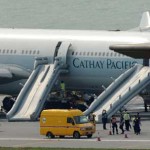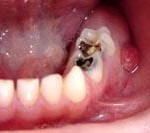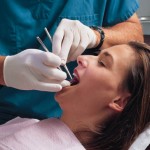Illness during a flight may lead to an unscheduled landing. This is expensive for the airline and extremely inconvenient for other passengers. There are relatively few situations where travel by flight is not allowed, and having a tooth abscess is one of them. Although the pain might not be so severe to the stage where the aircraft would have to do a force landing, however, different people have different level for tolerance of pain. So it is generally unwise to deliberately fly with a known tooth abscess in the mouth.
Most people are aware that the air gets thinner, providing less oxygen the higher you go. To help deal with this, commercial aircraft are pressurised to the equivalent of an altitude of 1500-2000m. This still results in a relatively small fall in oxygen saturation of the order of 3-5%, which may be significant for travellers whose oxygenation is already compromised by severe cardiac/respiratory disease. In practical terms, people with severe heart or lung disease who can walk 50m on level ground or ascend a flight of 12 domestic stairs are probably fit to fly.
An abscessed tooth is a painful infection at the root of a tooth or between the gum and a tooth. It’s most commonly caused by severe tooth decay. Other causes of tooth abscess are trauma to the tooth, such as when it is broken or chipped, and gingivitis or gum disease. These problems can cause openings in the tooth enamel, which allows bacteria to infect the center of the tooth (called the pulp). The infection may also spread from the root of the tooth to the bones supporting the tooth.
The whole issue is change of atmosphere pressure, so a person flying with your traditional commercial airline with pressurized cabin or private airline, with private aircraft that has pressurized cabin, there is little problems with that unless the person experiences a lot of stress in travel or flying. Stress always makes us more susceptible to the results of disease process. But if anything goes wrong with the pressurization, or anything changes dramatically in terms of the height of the aircraft (Large changes in altitude) can cause toothache (Barodontalgia = pressure-tooth-pain. A proposed classification of barodontalgia is given in a table below). The reason this occurs is either the presence of small pockets of gas in deep (usually unlined) fillings, or collections of gas in areas of decay, gum inflammation, or root abscesses. When that collection builds, it generates a lot more pressure, so the pressure that’s built up kind of pushes against the tooth and the gum causing an extreme amount of discomfort and the pain can be quite severe.
When you fly, you are subjected to different pressures and even though in the plane where the air is pressurized. There is always going to be fluctuations of pressure and this fluctuation of pressure can directly affect how that abscess feels. It will most likely make it worse when you go up in altitude, as you will feel more pressure on the abscess. And the more pressure on the abscess, the more unbearable it becomes to be.
There is little you can do, except descend, to treat this pain, however, a good short term remedy, found in many first aid kits, is Oil of Cloves which can be applied to the offending area. A high degree of dental hygiene and care is mandatory for aviators. That is why pilots that has any sort of dental infection or abscess will be advised not to fly based on the ability of the abscess to hurt further, and cloud the judgment of the pilot. Regular checkups with your dentist avoid this unnecessary risk of incapacitation. Following good oral hygiene practices can reduce the risk of developing a tooth abscess. Also, if your teeth experience trauma (for example, become loosened or chipped), seek prompt dental attention.
Proposed System of Classification of Barodontalgia
| Class | 1 | 2 | 3 | 4 | ||
| Chief Complaint | Sharp, momentary pain during ascent (decompression): asymptomatic on descent (compression) and afterwards | Dull, throbbing pain during ascent (decompression): asymptomatic on descent (compression) and afterwards. | Dull throbbing pain during ascent (decompression): asymptomatic on descent (compression) and afterwards. | Severe, persistent pain after ascent (decompression) or descent (compression) | ||
| Clinical Findings | Caries or restoration with inadequate base. Tooth is vital and x-ray shows no pathosis. | Deep caries or restoration.Tooth is vital/nonvital.X-ray shows no pathosis. | Caries or restoration.Tooth is nonvital.X-ray shows pathosis | Caries or restorationTooth is nonvital.X-ray shows definite pathosis | ||
| Diagnosis | Acute pulpitis | Chronic Pulpitis | Necrotic pulpitis | Periapical abscess or cyst. | ||
| Treatment | Sedative, temporary filling followed in two weeks with a well-based permanent restoration. Root canal therapy, if irreversible. | Root canal therapy | Root canal therapy or extraction of unrestorable tooth. | Root Canal therapy and/or surgery or extraction of unrestorable teeth | ||



Wow…didn’t know that. I just thought seriously ill people and pregnant women weren’t allowed to fly. Oh well. You learn something new every day.